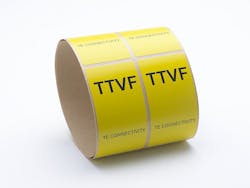Avoiding a case of mistaken identity: the importance of wire and cable identification
By Stephen Earley, TE Connectivity global product manager for wire and cable identification
As the aviation industry moves toward more-electric aircraft, manufacturers are introducing more condition-monitoring and infotainment solutions. In turn, the number of data and power connections is multiplying to serve sensors, screens, and controllers. In this environment, wires and cables must be properly identified so that technicians can be certain that they will find the right cables quickly during scheduled and unplanned maintenance operations.
Rapid delivery of maintenance tasks and fast resolution of problems can have a major impact on the availability of aircraft. Without accurate and informative identification markers, a simple task of tracing and testing a cable can become extremely complex and time consuming – so the hidden costs of choosing the wrong identification product can be significant.
"It’s important to select the right type of identification marker
for the job, and both the ink and printing technique are just as
important as the label or sleeve itself."
Remaining in place and readable
The role of wire and cable identification products is to remain in place and legible even after years of exposure to extremely harsh and widely cycling environmental changes. This can include exposure to extreme cold at high altitudes, heat from engines and other equipment, as well as kerosene, lubricants, cleaning agents, and moisture.
Flight is also mechanically tough and wiring harnesses can be vulnerable to the effects of vibration, shocks and abrasion. Lastly, the markers should play a role in minimizing the risks associated with fire with self-extinguishing properties.
Materials science
Although they seem straightforward at first glance, a vast amount of materials science and development has been poured into cable markers to guarantee the performance that helps aircraft technicians to deliver a fast turn-around.
Markers tend to be based on polymer materials such as polyethylene or polyvinylfluoride. However, to achieve the high performance needed in aerospace, manufacturers like TE Connectivity must add minerals and other additives. Some products, such as those first developed by the Raychem brand, need to be irradiated to create the links between polymer chains that form the basis of a cross-linked polymer matrix.
Many factors can affect the quality and performance of the product during manufacture so tight control is needed at every step so that every batch delivers guaranteed high performance. Production temperatures, mixing rates, quality of raw materials and even the grain size of mineral additives all influence the quality of the end product – and its ability to remain in place after a tough flight schedule.
System approach
Apart from remaining in situ, markers must remain readable, in some cases many years after installation. To guarantee this performance, manufacturers put products through stringent development and testing of the mark and the material in combination.
So identification markers are not just a product but a system that should be adopted as a whole. For all printable markers, this includes the printer, printer ribbon, and labelling software that generates the correct settings for print.
One popular example in aerospace is the TMS-SCE marker, a heat-shrinkable sleeve that has demonstrated performance over decades. Another is the multi-purpose TTVF label that can be printed with bar codes and used as a flagging or wrap-around label or a flat sticker to identify terminals on a panel or other equipment.
Overall, it is clear that for aircraft engineers and technicians, selecting the right ident to withstand the rigors of aviation applications is just as important as selecting the right cable.
Stephen Earley is the global product manager for TE’s cable identification products. He has long experience in the identification market dating back to 1992 and joined TE in 2015 to drive the business across the harsh environment markets globally.
Search the Aerospace & Defense Buyer's Guide
The go-to resource for Intelligent Aerospace technology news & information:
Covering key topics
Across all market segments
Subscribe to the free Intelligent Inbox e-newsletter
Subscribe to receive all the latest aerospace technology news & information, delivered directly to your e-mail inbox twice a week (Tuesdays and Thursdays). Sign upfor your free subscription to the Intelligent Inbox e-newsletter at http://www.intelligent-aerospace.com/subscribe.html.
Connect on social media
Keep pace with aerospace innovation and opportunities via your favorite social media channels. Connect with Intelligent Aerospace on Twitter (@IntelligentAero), LinkedIn,Google+, and Instagram.





